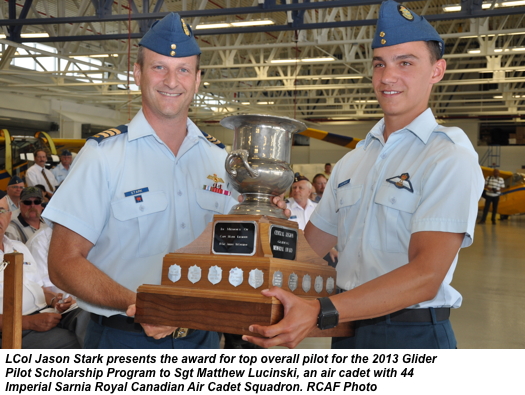By Ross Lees/RCAF | August 22, 2013
Estimated reading time 3 minutes, 45 seconds.
Central Region Gliding School graduates can often fly before they can drive a car!
A majority of the cadets who graduated from the Central Region Gliding School (CRGS) on Friday, August 9, 2013, can’t drive a car, but they can now fly a glider.
Lieutenant-Colonel Jason Stark, the former commanding officer of 429 Transport Squadron, pointed that out to the parents and relatives of the graduates who were in attendance, adding there’s no better feeling than flying solo for the first time and especially getting that true sense of flying only available in a glider.
He used a story to put their accomplishment into perspective.
A glider pilot flying at 1,500 feet looks up and sees a Cessna pilot flying at 3,000 feet and says, “Man, I’d love to be a Cessna pilot.”
The Cessna pilot looks up and sees a King Air pilot flying at 6,000 feet and says, “Man, would I love to be flying a King Air.”
The King Air pilot looks up at an airline pilot flying at 30,000 feet and wishes he could be an airline pilot.
The airline pilot looks into space and wishes he could be Chris Hadfield.
But Chris Hadfield is looking way back down at that glider and saying, “I would love to be in that glider right now!”
“I know that over the past six weeks, you’ve all worked incredibly hard, you’ve demonstrated the professionalism, the commitment, dedication, skill and talent required to as they say, ‘slip the surly bonds of earth,’ and join all your fellow pilot brethren,” he told the graduating cadets.
He recalled taking the first steps along his path of aviation – a path which began at the Central Region Gliding School – and continuing along that path into the Canadian Armed Forces.
“For any of you that want to pursue that path, I can tell you I have no regrets. I have over 5,000 hours of flying experience, in the CC-130 [Hercules] and the CC-177 [Globemaster III], I’ve been to the Arctic, the Antarctic, Asia, the Middle East, Europe, the Pacific and pretty much everywhere I ever dreamed I would want to go. All of that I’m able to do because of the wings I have on my chest,” he said.
LCol Stark said that these pilots learn there are no do-overs when flying a glider.
“When they release from that tow-plane, every decision they make is critical to ensuring that plane, that glider, goes back to the same place it took off from,” he said.
“All of you have shown the decision-making required to do that or we would not have pinned those wings on your chests today,” he continued. “Flying a glider is careful management of altitude and speed, assessment of winds and assessment of where you are and your space,” he noted.

